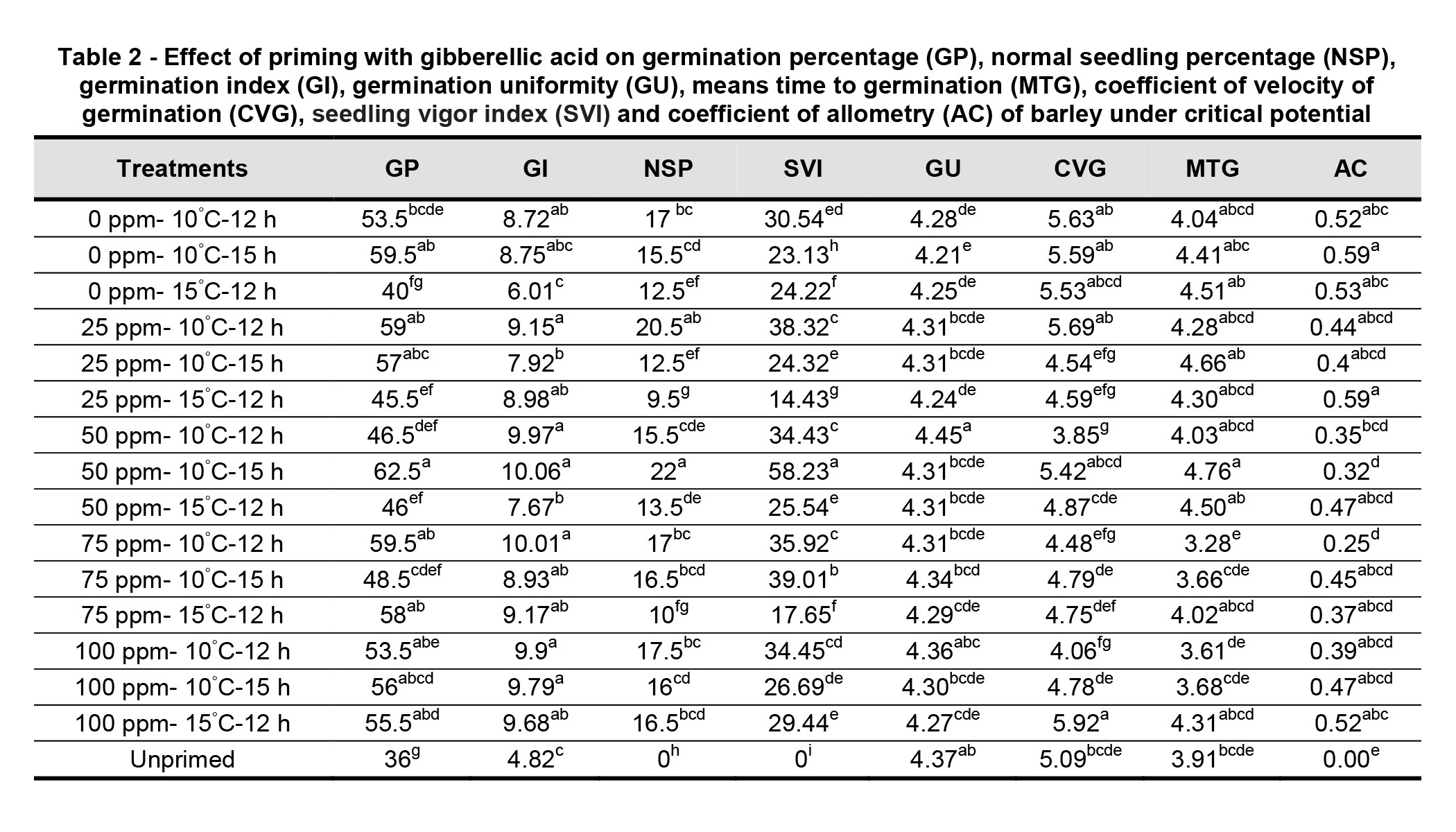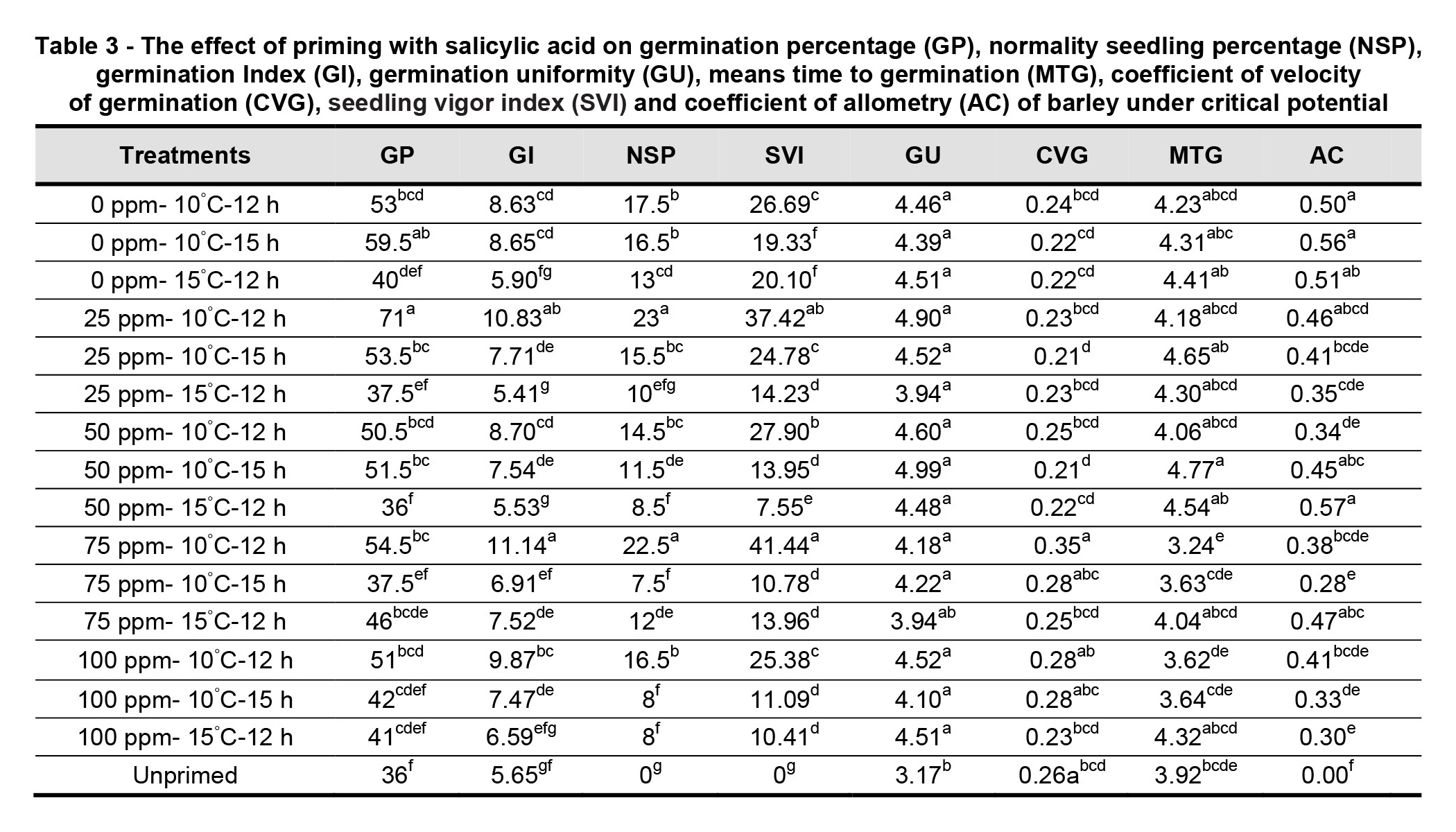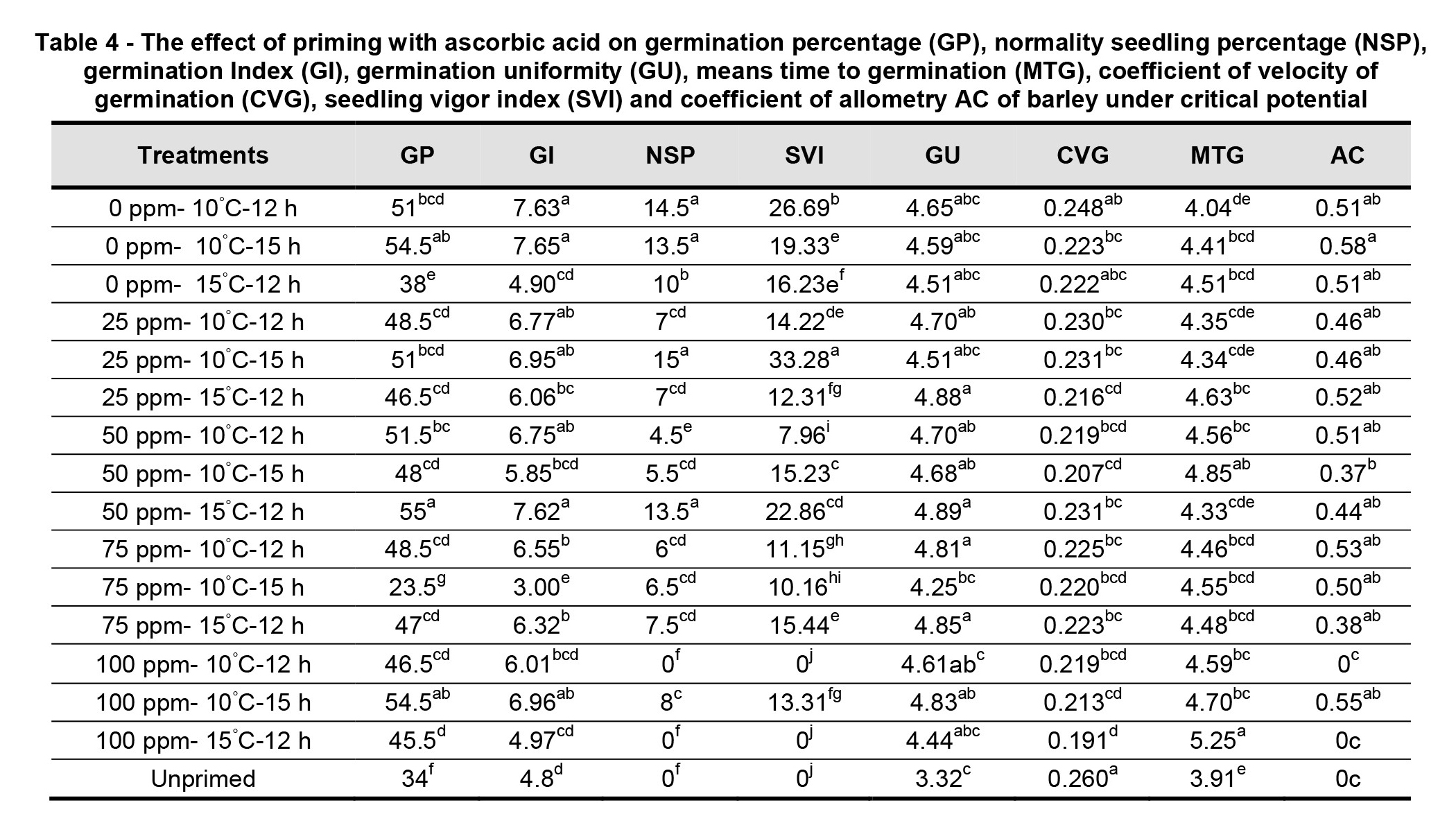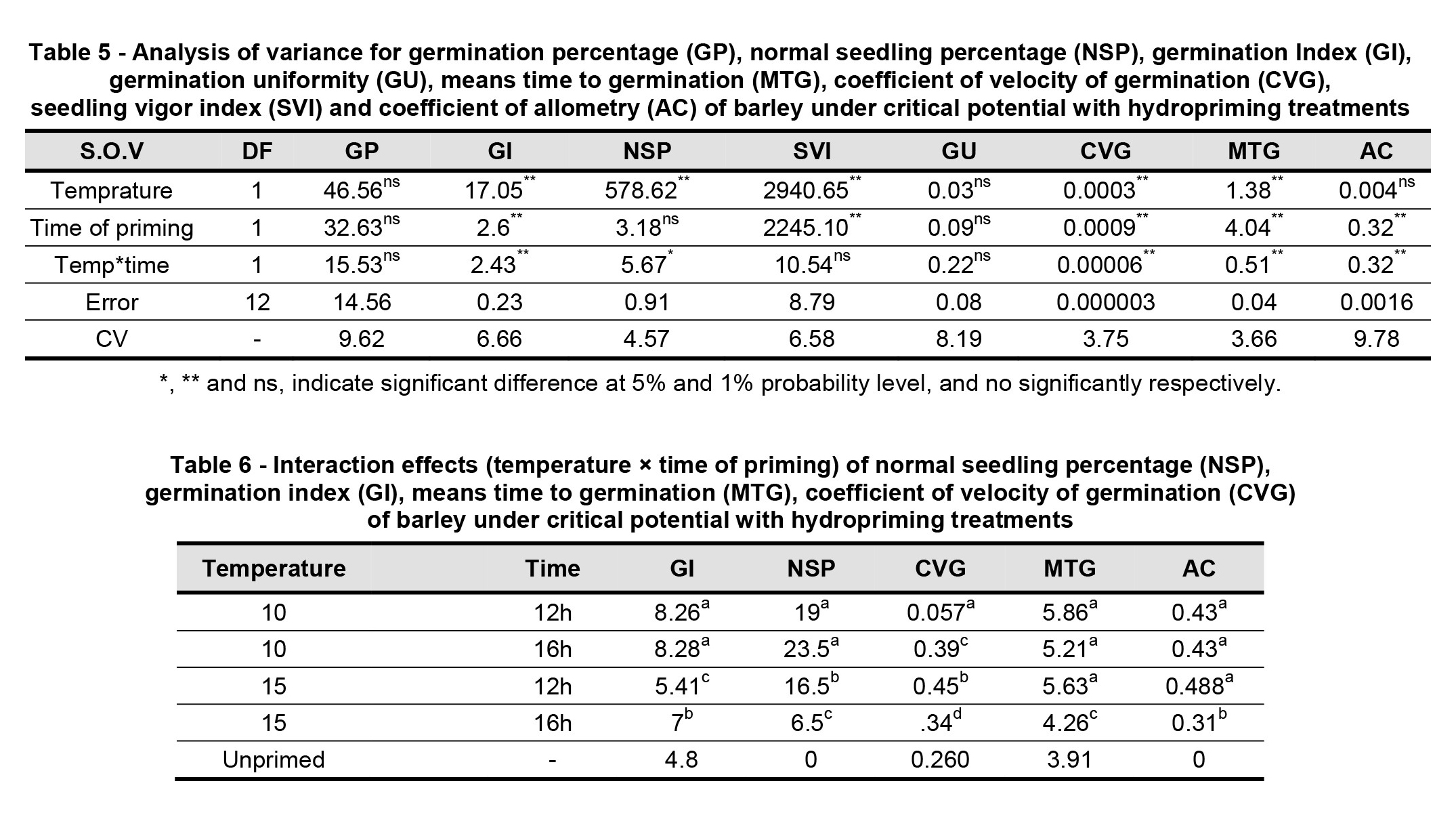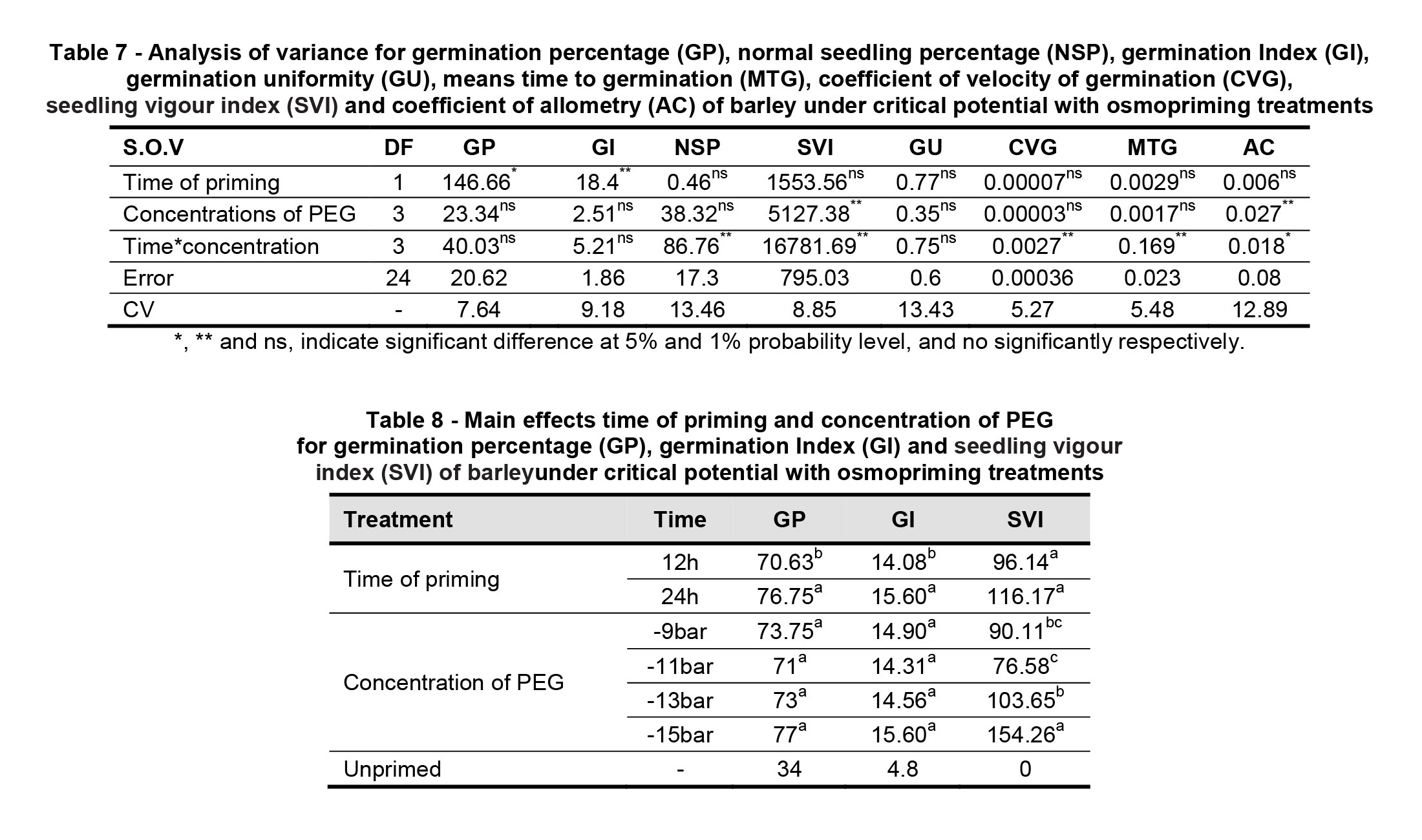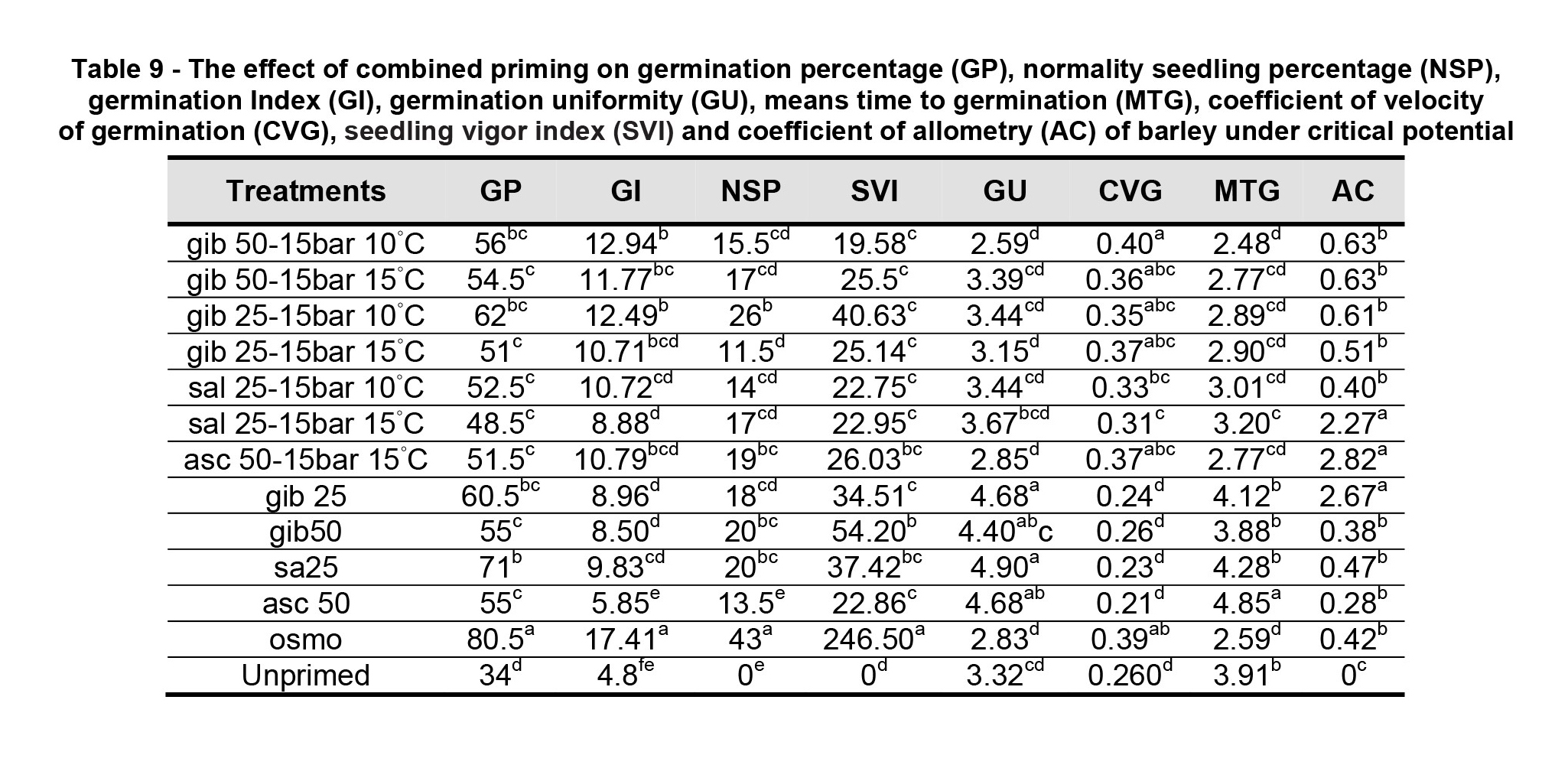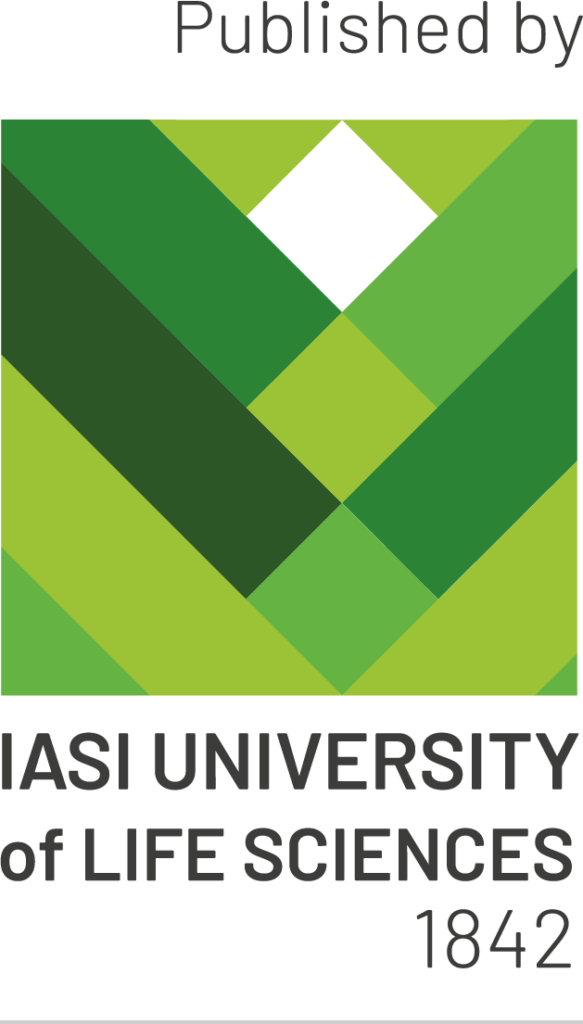S.A. Tabatabaei, O. Ansari
ABSTRACT. Seed priming methods have been used to increase germination and seedling establishment under different abiotic stress conditions. Seed priming was used in barley to increase seed germination and tolerance on stress exposure. Barley seeds were treated with various priming agents for different time and temperatures. The effect of priming was assessed on germination characteristics on subsequent exposure to drought (PEG-12 bar) stress for 7 days. Seed priming treatments significantly (p≤ 0.01) affected germination percentage (GP), normality seedling percentage (NSP), germination Index (GI), germination uniformity (GU), means time to germination (MTG), coefficient of velocity of germination (CVG), seedling vigor index (SVI) and coefficient of allometry (AC). Seed priming with gibberelic acid (GA), salicylic acid (SA), ascorbic acid (ASc), hydropriming (HP), osmopriming (OP) and combined treatments (CT) significantly (p≤ 0.01) increased germination characteristics, compared to the unprimed. Seed priming with concentrations 25, 50 ppm of GA for 15 h at 10°C, 25 ppm of SA for 12 h at 10°C, 50 ppm of ASc for 12 h at 15°C, treatment 16 h hydropriming at 10°C and -15 bar PEG for 24 h for osmopriming maybe considered as optimal treatment for priming of barley seeds in drought stress conditions. In some cases, combined treatments are better than the separate treatments. Seed priming with PEG (potential -l5 bar PEG for 24 h at 10°C) was more effective in drought stress than the other treatments.
Keywords: seed priming; Hordeum vulgare L.; drought stress.
View full article (HTML)
The Effect of Priming on Germination Characteristics of Barley Seeds under Drought Stress Conditions
S.A. Tabatabaei1, O. Ansari2,*
1Seed and Plant Improvement Research Department, Yazd Agricultural and Natural Resources and Education Center, AREEO, Yazd, Iran
2Seed Science and Technology, Gorgan University of Agricultural Sciences and Natural Resources, Gorgan, Iran
*E-mail: omid0091@yahoo.com
Received: Apr. 13, 2020. Revised: May, 25, 2020. Accepted: May 30, 2020. Published online: June 5, 2020
ABSTRACT. Seed priming methods have been used to increase germination and seedling establishment under different abiotic stress conditions. Seed priming was used in barley to increase seed germination and tolerance on stress exposure. Barley seeds were treated with various priming agents for different time and temperatures. The effect of priming was assessed on germination characteristics on subsequent exposure to drought (PEG-12 bar) stress for 7 days. Seed priming treatments significantly (p≤ 0.01) affected germination percentage (GP), normality seedling percentage (NSP), germination Index (GI), germination uniformity (GU), means time to germination (MTG), coefficient of velocity of germination (CVG), seedling vigor index (SVI) and coefficient of allometry (AC). Seed priming with gibberelic acid (GA), salicylic acid (SA), ascorbic acid (ASc), hydropriming (HP), osmopriming (OP) and combined treatments (CT) significantly (p≤ 0.01) increased germination characteristics, compared to the unprimed. Seed priming with concentrations 25, 50 ppm of GA for 15 h at 10°C, 25 ppm of SA for 12 h at 10°C, 50 ppm of ASc for 12 h at 15°C, treatment 16 h hydropriming at 10°C and -15 bar PEG for 24 h for osmopriming maybe considered as optimal treatment for priming of barley seeds in drought stress conditions. In some cases, combined treatments are better than the separate treatments. Seed priming with PEG (potential -l5 bar PEG for 24 h at 10°C) was more effective in drought stress than the other treatments.
Keywords: seed priming; Hordeum vulgare L.; drought stress.
INTRODUCTION
Barley is one of the most widely grown crops in arid and semiarid regions of the world. The seeds of barley show a delayed or reduced germination when the water potential of surrounding medium decreases. Stress conditions are widespread problem around the world.
Seed germination is usually essential process in seedling establishment and plant development to obtain seedling numbers those results in higher seed crop (Almansouri et al., 2001, Murungu et al., 2003). In more crop species, seed germination and establishment are the most sensitive stages to abiotic stress (Patade et al., 2011, Redmann, 1974. Murrillo-Amador et al., 2002, Khajeh Hossaini et al., 2003). Abiotic stress, such as drought stress, salt stress and cold stress, may be delay seed germination percentage and reduce the germination rate (Patade et al., 2011). Seed priming is one of the techniques that can be taken to counteract the adverse effects of abiotic stress (Patade et al., 2009; Ashraf and Foolad, 2005). The purpose of seed priming is to a partially hydrated with water, or various chemical solutions like polyethylene glycol (osmopriming) or salts like CaCl2, CaSo4 and NaCl (halopriming) the seeds to a point where germination processes are begun, but not completed (Asfraf and Foolad, 2005), followed by drying of seeds to the original moisture level (McDonald, 2000). Seed priming techniques have been used to increase germination, improve germination uniformity, improve seedling establishment and stimulate vegetative growth in more field crops, such as: wheat (Iqbal and Ashraf, 2007), sunflower seeds (Kaya et al., 2006), chickpea (Kaur et al., 2002), capsicum (Patade et al., 2011) and soybean (Sadeghi et al., 2011), under stressed conditions. Also, similarity indicated in maize (Foti et al., 2008), cucumber (Ghasemi-Golezani and Esmaeilpour, 2008). Priming has also been shown to induce nuclear DNA synthesis in the radicle tip cells in several plant species including: tomato (Liu et al., 1997), pepper (Capsicum annuum) (Lanteri et al., 1993), maize (Zea mays) (Garcia et al., 1995), and leek (Ashraf and Bray, 1993).
The study aimed was to determine the effect of different priming treatments on germination seedling growth of barley under drought stress and to find the best combination and time regime in different materials priming.
MATERIALS AND METHODS
The study was conducted in the laboratory of Seed and Plant Improvement Research Department, Yazd Agricultural and Natural Resources and Education Center, AREEO, Yazd, Iran.
Determine the critical drought potential
Drought tolerance of barley seeds was tested by using solutions of 0,-2, -4, -6, -8 ,-10 , -12, -14 and -16 bar polyethylene glycol (PEG-6000) concentrations, using a randomized complete design with four replications. Barley seeds were germinated in 10 cm glass Petri dishes containing 6 ml PEG 6000 solution in a germinator at 20±1°C, in dark condition for 7 days. Germinated seeds were recorded every 1 day for 7 days. After test time expiration, for determine the critical drought potential, some germination indexes were evaluated, such as: germination percentage (GP) and normality seedling percentage (NSP).
Seed priming
Seeds of were pretreated with water (hydropriming), polyethylene glycol (osmopriming), salicylic acid, gibberellic acid and ascorbic acid. For osmopriming treatments used solution of -9, -11, -13 and -15 bar PEG 6000 concentrations for 12 and 24 h at 15±1°C. The seeds were imbibed in distilled water for 8 and 16 h at 10 and 15°C in hydropriming treatments. In hormone priming treatments, seeds were exposure in 0 ppm, 25 ppm, 50 ppm, 75 ppm and 100 ppm concentrations salicylic acid, ascorbic acid and gibberellic acid for 12 and 15 h at 10±1°C and 12 h at 15±1°C. Barley seeds were exposure in 20 cm glass Petri dishes containing 15 ml solution. The imbibed seeds were then washed three times with tap water and dried on filter paper at 25±1°C for 24 h. Combined treatment consisted of gibberellic acid 25 ppm at 10°C with PEG -15 bar.
Combined treatments (hormonal priming with PEG)
Combined the best treatments hormone priming (gib 25 and 50 and sal 25 ppm and asc 50 ppm) and osmopriming (-15 bar).
Seed germination and seedling growth
Seeds of primed and unprimed, barley for drought tolerance were placed in 10 cm glass Petri dishes containing 5 ml, critical potential in a germinator at 20±1°C for 7 days. Four replicates of 50 seeds for each treatment were used. Seeds were considered germinated when a 1 mm length radicle protruded through the seed coat. Germinated seeds were recorded every 24 h for 7 days. After test time expiration, some germination indexes were evaluated, such as: germination percentage (GP), normality seedling percentage (NSP), germination Index (GI), germination uniformity (GU), means time to germination (MTG), coefficient of velocity of germination (CVG), seedling vigour index (SVI) and coefficient of allometry (AC).
Statistical analysis
All data were analyzed statistically by analysis of variance using SAS software. The factorial experiments were carried out using a randomized complete design with four replications for osmopriming and hydropriming and using a randomized complete design with four replications for salicylic acid, gibberellic acid and ascorbic acid. Mean comparisons were performed using an ANOVA protected least significant difference (Duncan) (p< 0.01) test.
RESULTS
Critical drought tolerance test
Seed germination of barley was significantly affected (p< 0.01) by PEG concentrations (Table 1). The highest germination percentage and normal seedling percentage was attained from distilled water, followed by -2 and -4 bar PEG. The highest PEG concentrations (-14 and -16 bar PEG) showed substantial reduction in seed germination (Table 1) and showed substantial reduction in normal seedling percentage (Table 1). The differences between the variants were significant and mathematically proven (p< 0.01). However, none of the treatments had a statistically significant effect on seed germination and normal seedling percentage until -6 bar PEG, whereas -14 and -16 bar treatments significantly reduced the germination and normality seedling percentage (Table 1). Barley seeds were more sensitivity in a higher concentration of -12 bar.
Table 1
Changes of the germination percentage (GP) and normality seedling percentage (NSP) of barley seeds under different PEG concentration solution
|
PEG concentration solution (bar) |
Germination percentage |
Normal seedling percentage |
|
0 |
90a |
88a |
|
-2 |
89.5a |
82b |
|
-4 |
88a |
76.5c |
|
-6 |
74b |
62.5d |
|
-8 |
70b |
56e |
|
-10 |
64.5c |
36.5f |
|
-12 |
46.5d |
18.5g |
|
-14 |
36e |
0h |
|
-16 |
21.5f |
0h |
Treatments seed priming
Priming with gibberellic acid
Results showed that the highest germination percentage (GP), germination index (GI), normal seedling percentage (NSP) and seed vigor index (SVI) were attained from treatment 50 ppm of GA at 10°C. for 15 h (Table 2). The minimum germination uniformity (GU) was attained from 0 ppm at 10°C for 15 h (Table 2). Coefficient of velocity of germination (CVG) was significantly improved in barley seeds primed with treatments, 0 ppm at 10°C for 12 and 15 h, 0 ppm at 15°C for 12 h, 25 ppm at 10°C for 12 h and 100 ppm at 10°C for 12 h (Table 2). The minimum means time to germination (MTG) was attained from treatment, 50 ppm at 10°C for 12 h and the highest coefficient of allometry (AC) was attained from treatment, 0 ppm at 10°C for 15 h and 25 ppm at 15°C for 12 h (Table 2).
Priming with salicylic acid
Results for SA showed that germination percentage (GP) and germination index (GI) was significantly improved in seeds primed with concentration 25 ppm SA at 10°C for 12 h, normal seedling percentage (NSP) was significantly improved in seeds primed with concentrations 25 ppm SA at 10°C for 12 h, as compared to the unprimed and other concentrations SA (Table 3). The highest seed vigor index (SVI) and coefficient of velocity of germination (CVG) were attained from treatment, 75 ppm SA at 10°C for 12 h. Germination uniformity (GU) was no significantly difference in barley seeds primed with all treatments SA, as compared to the unprimed (Table 3). The highest and minimum means time to germination (MTG) was attained, respectively, from 50 ppm SA at 10°C for 15 h and 75 ppm SA at 10°C for 12 h (Table 3).
The best treatment for coefficient of allometry (AC) attained from treatments 0 ppm in 10°C for 12, 15 h and 50 ppm SA at 15°C for 12 h (Table 3).
Priming with ascorbic acid
Germination percentage (GP) was significantly improved in barley seed primed with 50 ppm ASc at 15°C for15 h, as compared to the unprimed and other treatments (Table 4). The best treatments for germination index (GI) were attained from 0 ppm at 10°C for 12, 15 h and 50 ppm ASc at 15°C for 12 h. The highest normal seedling percentage (NSP) was attained from 25 ppm ASc at 10°C for 15 h, but no significant difference whit treatments, 0 ppm at 10°C for 12, 15 h and 50 ppm ASc at 15°C for 12 h and the highest seed vigor index (SVI) was attained from 25 ppm at 10°C for 15 h (Table 4). Germination uniformity (GU) was significantly improved in barley seeds primed with all treatments ASc, as compared to the unprimed (Table 4). Coefficient of velocity of germination (CVG) was reduced in seeds primed with ASc. Means time to germination (MTG) significantly improved in barley seeds primed with treatments, 50 ppm ASc at 10°C for 15 h and 100 ppm ASc at 15°C for 12 h, as compared to the other treatments primed whit ASc and unprimed.
The highest coefficient of allometry (AC) was attained from treatment, 0 ppm at 10°C for 15 h, but no significantly difference with other treatments, except treatments: 50 ppm ASc at 10°C for 15 h and 100 ppm ASc at 10°C for 10 h (Table 4).
Hydropriming
Variance analysis of first experiment was investigated in order to studying hydropriming effect on barley seeds in different time and temperature. Analysis of variance showed that there is a significant interaction effects (temperature × time of priming) for normal seedling percentage (NSP), germination index (GI), means time to germination (MTG), coefficient of velocity of germination(CVG), seedling and coefficient of allometry (AC) (Table 5). Main effects of temperature on all factors measured significant expect germination uniformity (GU), but main effects of time of priming no significantly on germination percentage (GP), seedling vigor index (SVI) and germination uniformity (GU) (Table 5). Results of interaction effects showed that minimum means time to germination (MTG) and seedling and coefficient of allometry (AC), attained in treatment hydropriming 16 h at 15°C (Table 6).
The highest normality seedling percentage (NSP) and coefficient of velocity of germination (CVG), respectively, were obtained from hydropriming 12, 16 h at 10°C and 12 h hydropriming at 10°C (Table 6).
Osmopriming
Analysis of variance showed that there is a significant interaction effects (temperature × time of priming) for normal seedling percentage (NSP), seedling vigor index (SVI), coefficient of velocity of germination (CVG) and means time to germination (MTG) (Table 7). Results showed that the highest germination percentage (GP) and germination index (GI) obtained from temperature 24°C (Table 8). The highest coefficient of allometry (AC) for concentrations of PEG obtained with concentration -9 bar PEG (Table 8). Results of interaction effects showed that maximum germination percentage (GP) and normal seedling percentage (NSP) obtained from priming treatment whit -15 bar PEG for 24 h (Fig. 1). The highest coefficient of velocity of germination (CVG) obtained whit treatment -13 bar PEG for 12 h (Fig. 2), and the highest means time to germination (MTG) obtained whit treatment -13 bar PEG for 24 h (Fig. 3). The maximum coefficient of allometry (AC) attained from treatment -13 bar PEG for 24 h at 10°C (Fig. 4).
Thus, seed priming with concentration 25, 50 ppm of GA for 15 h at 10°C, concentration 25 ppm of SA for 12 h at 10°C, concentration 50 ppm of ASc for 12 h at 15°C, treatment 16 h hydropriming at 10°C for hydropriming and for osmopriming -15 bar PEG for 24 h may be considered as optimal treatment for priming of barley seeds in drought stress.
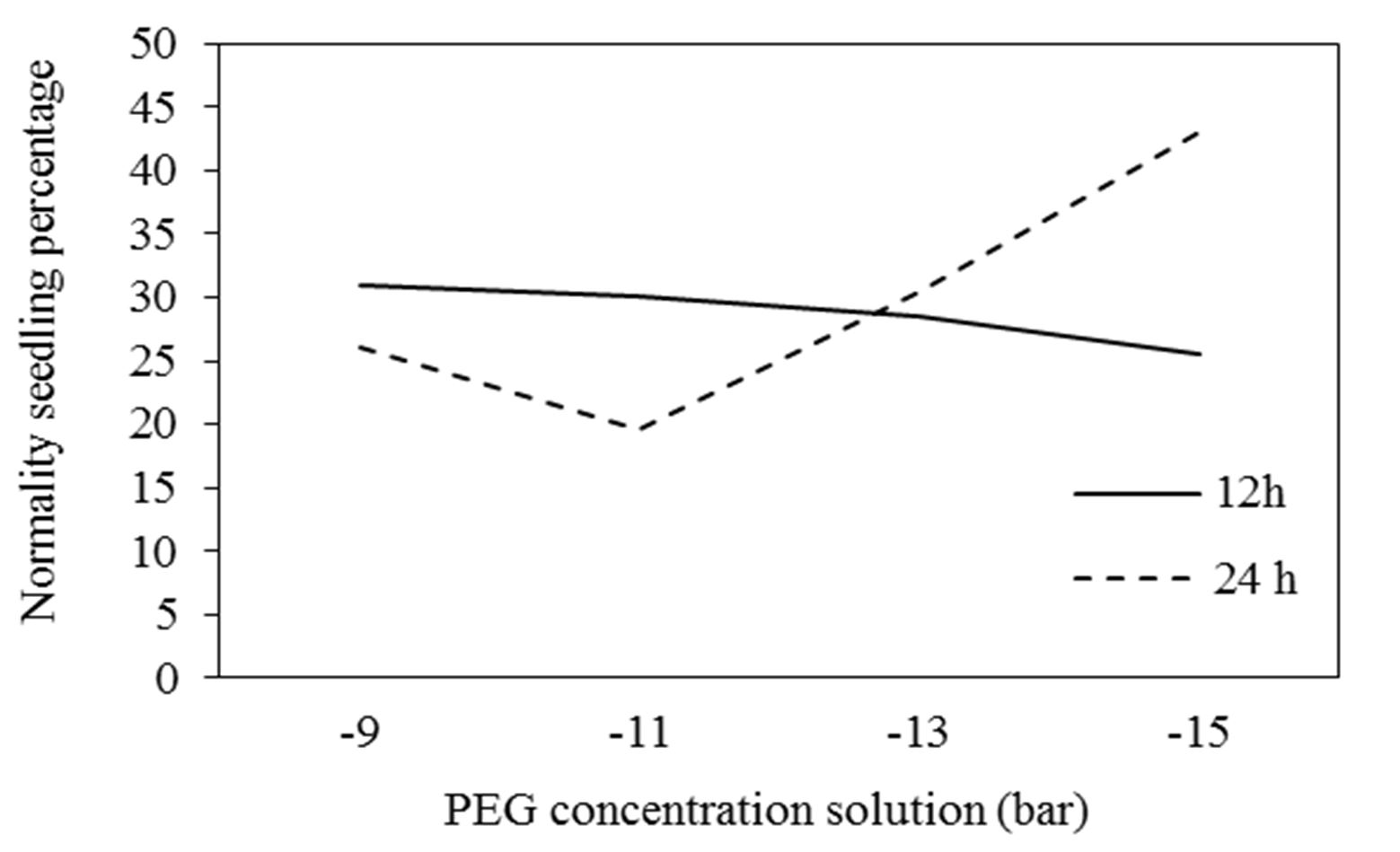
Figure 1 – Interaction effects (time of priming × concentration of PEG) on normal seedling percentage (NSP) barley under critical potential
Combined hormonal priming with PEG
Combined treatment gibberellic acid 25 ppm at 10°C with PEG -15 bar increased germination percentage (GP) than the treatment gibberellic acid 25 ppm at 10°C for 12 h (Table 9). Germination index (GI) increased in all combined treatments expect for salicylic acid (Table 9).
Normality seedling percentage (NSP) reduce in combined treatment expect gibberellin 25 ppm and ascorbic 50 ppm (Table 9). Seedling vigor index (SVI) was no significantly difference in barley seeds primed with hormone and combined treatments (Table 9). The minimum germination uniformity (GU) was attained from combined treatment gibberellic acid 50 ppm with PEG -15 bar at 15°C (Table 9). The highest coefficient of velocity of germination (CVG), means time to germination (MTG), was attained in barley seeds with combined treatment gibberellic acid 25 ppm at 10°C with PEG -15 bar (Table 9). The highest coefficient of allometry (AC) was attained with combined treatments, salicylic acid 25 ppm and ascorbic acid 50 ppm at 15°C with PEG -15 bar and gibberellic acid 25 ppm (Table 9).
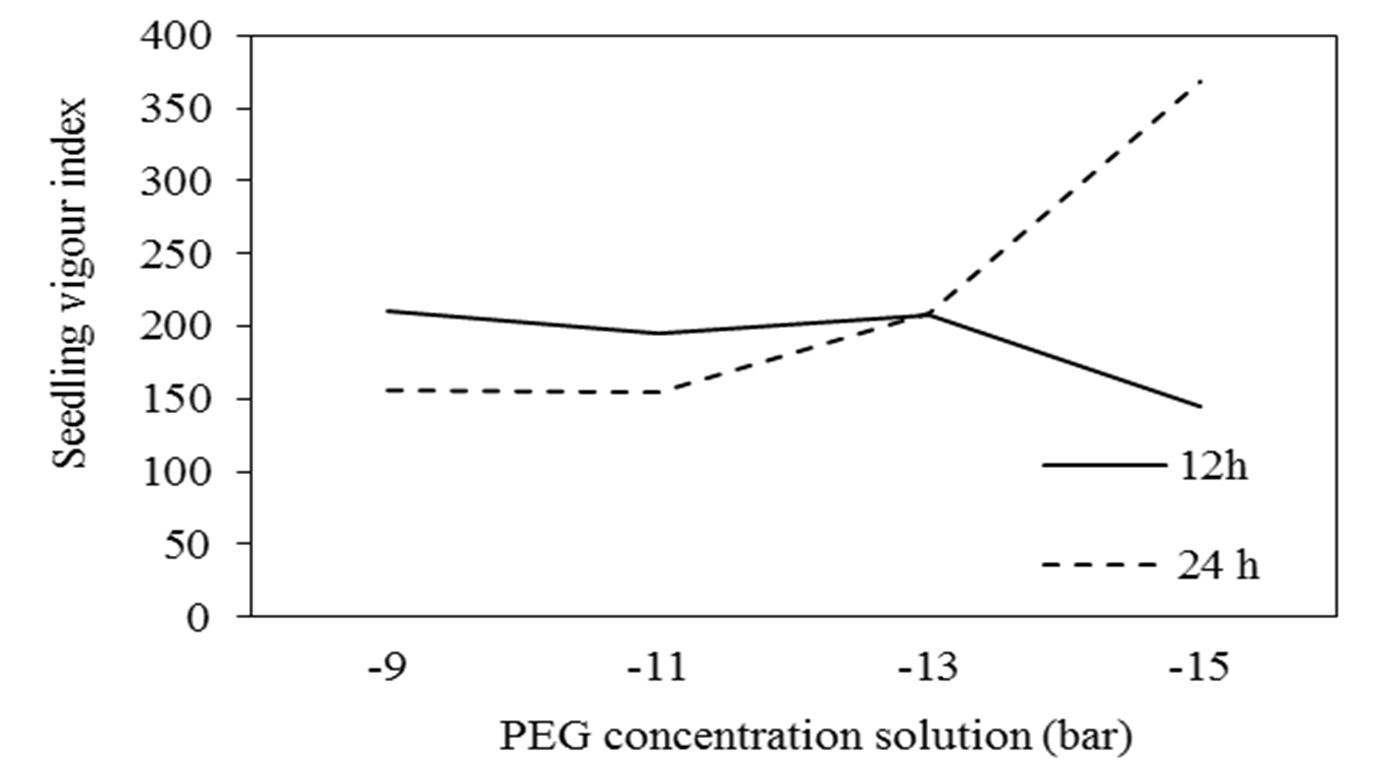
Figure 2 – Interaction effects (time of priming × concentration of PEG) on seedling vigour index (SVI) barley under critical potential
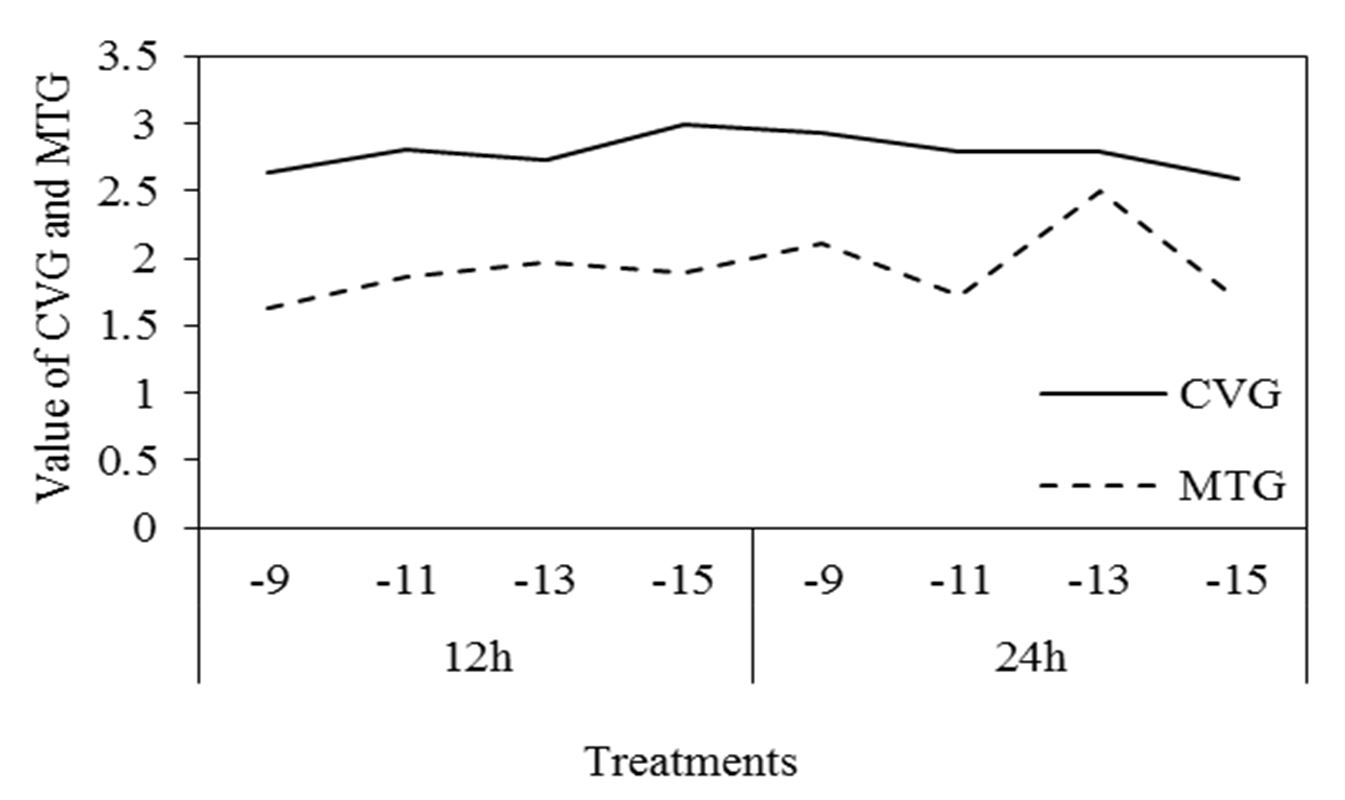
Figure 3 – Interaction effects (time of priming × concentration of PEG) on means time to germination (MTG) and coefficient of velocity of germination (CVG) of barley under critical potential
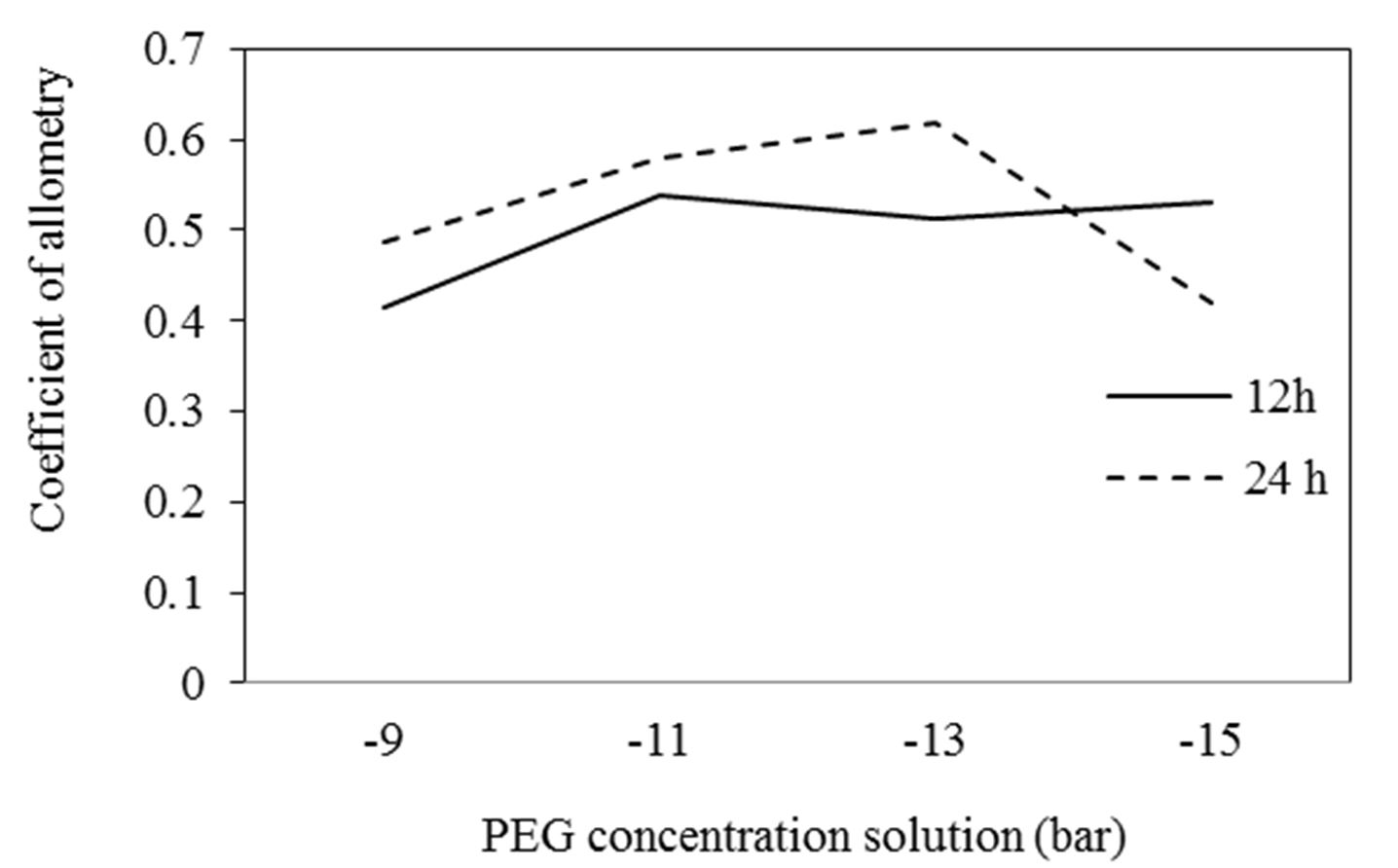
Figure 4 – Interaction effects (time of priming × concentration of PEG) on coefficient of allometry (AC) barley under critical potential
DISCUSSION
Results showed that drought stress affected germination characteristics, such as: germination percentage (GP), normal seedling percentage (NSP), germination Index (GI), germination uniformity (GU), means time to germination (MTG), coefficient of velocity of germination (CVG), seedling vigor index (SVI) and coefficient of allometry (AC) in barley. Potential of -6 bar PEG or higher concentration reduced the germination characteristics significantly. The results are in agreement with the earlier study Ansari and Sharif-Zadeh (2012), who reported the significant reduction in the germination, as well as growth of mountain rye. As the PEG concentration of -14 and -16 bar inhibited completely the normal seedling percentage, therefore, -14 bar PEG was used to study the potential critical in barley seeds. Seed germination and seedling growth are critical stages in the life cycle of a plant, especially under adverse abiotic stresses. Seed priming is one of the methods that can be taken to counteract the adverse effects of abiotic stress (Patade et al., 2009; Ashraf and Foolad, 2005).
In the present study, effect of various seed priming agents was assessed on germination and seedling growth, under control conditions, various seed priming, significantly increased germination index (GI) (data not shown).
In agreement with the results, earlier reports (Sadeghian and Yavari, 2004; Chen et al., 2005; Kaya et al., 2006) have shown positive effect of priming in relation to seed performance, germination percentage and seedling indices.
However, the priming treatments in the present investigation, like gibberellin, salicylic, ascorbic acid, hydro and osmopriming with appropriate concentration, temperature and time, improved germination characteristics. Seed priming with all prime materials in this experiment improved germination percentage (GP), normality seedling percentage (NSP), germination Index (GI), germination uniformity, seedling vigor index (SVI) and other traits than unprimed expect some treatments for some traits. Concentrations minimum gibberellic acid better than the higher concentrations. Gibberellic acid increase the synthesis of hydrolytic enzymes at aleurone layer and by the activity of these enzymes, storage compounds convert to transferable and transfer to embryo (Sedghi et al., 2008).
Gibberellin treatments may improve rapid and uniform seedling germination-emergence and plant development in nurseries and in greenhouses (Tzortzakis, 2009). Also, salicylic acid and ascorbic acid increased germination percentage and other germination indices, as compared to unprimed. The promotive effect of salicylic acid on shoot and root parameters has been reported in wheat and barley (Singh and Usha, 2003; Hayat et al., 2005; El-Tayeb, 2005). Salicylic acid changes the balance of hormones in plants, increased IAA and ABA and prevented the reduction of cytokines under no stress conditions (Shakirova et al., 2003). Improved germination and seedling growth were recorded in wheat, when the seeds were subjected to pre-sowing seed-soaking treatment in salicylic acid (Shakirova, 2007).
Ascorbic acid is one of the best identified non-enzymatic compounds as antioxidant that plant bearing is increased to oxidative stresses (Smirnoff, 1996). Treat of wheat seeds to ascorbic acid decreased bad effective’s drought stress on fresh and dry weight of radical and plumule (Hamad and Hamada, 2001). Afzal et al. (2006) reported that ascorbate and salicylic acid caused reduction of effectives salinity stress on the germination and seedling growth of wheat. It was identified that salicylic acid regulate cell division, cell extension and death (Zhang et al., 2002). Positive effect of 12 and 24 h osmo and hydropriming on the percentage and mean emergence time under sub-optimal temperature of 15°C in sorghum (Moradi and Younesi, 2009). But, our results showed that the highest germination percentage (GP), normality seedling percentage (NSP) and seedling vigor index (SVI) was at 10°C for 16 and 24 h, respectively, for hydro and osmopriming.
The increased in germination percentage (GP), normality seedling percentage (NSP) and seedling vigour index (SVI) and germination index (GI), maybe due to reserve mobilization of food material, activation and re-synthesis of some enzymes synthesis start during priming. Osmopriming can contribute to improve seedling emergence in different plant species by increasing the expression of aquaporin (Gao et al., 1999), improvement of ATPase activity, RNA and acid phosphatase synthesis (Fu et al., 1998), also bye improve of amylases, lipases and protease synthesis (Ashraf and Foolad, 2005). Prime treatments combined had effect on germination and growth seedling than the treated separately in some treatments. Thus, can said, effect of treatments priming on germination and seedling growth related to concentrate, time of priming, temperature for priming and plant species.
CONCLUSION
Seed priming treatments improved germination percentage (GP), normality seedling percentage (NSP) and seedling vigor index (SVI), and reduced germination uniformity (GU), means time to germination (MTG), coefficient of velocity of germination (CVG) in Secale montanum under stressed conditions. Among the treatments, seed priming with PEG (osmopriming) was mor effective in drought stress than the other treatments. Thus, it is conclude that under drought stress, priming could be as suitable, especially osmopriming with potential – l5 bar PEG for 24 h at 10°C.
REFERENCES
Afzal, I., Basra, S.M.A., Farooq, M. & Nawaz, A. (2006). Alleviation of salinity stress in spring wheat by hormonal priming with ABA, salicylic acid and ascorbic acid. Int.J.Agric. Biol., 8(1-: 23-28.
Ansari, O. & Sharif-Zadeh, F. (2012). Osmo and hydro priming mediated germination improvement under cold stress conditions in mountain rye (Secale montanum). Cercet.Agron. în Moldova, 3 (151): 53-62.
Ashraf, M. & Foolad, M.R. (2005). Pre-sowing seed treatment-a shotgun approach to improve germination, plant growth and crop yield under saline and none-saline conditions, Advan.Agron., 88: 223-271.
Ashraf, M. & Bray, C.M. (1993). DNA synthesis in osmoprimed leek (Allium porrum L.) seeds and evidence for repair and replication. Seed Sci.Technol., 3(1):15-23, DOI: 10.1017/S0960258500001525
Chen, D., Bodapasti, N., Gunawardena, T.A., Naidub, P., Fukai, S. & Basnaykae, J. (2005). Seed treatment with gibberellic acid and glycinebetaine improves seedling emergence and seedling vigour of rice under low temperature. Seed Sci.Technol., 33: 471-479.
El-Tayeb, M.A. (2005). Response of barley grains to the interactive effect of salinity and salicylic acid. Plant Growth Regul., 45(3): 215-224, DOI: 10.1007/s10725-005-4928-1
Foti, R., Abureni, K., Tigere, A., Gotosa, J. & Gerem, J. (2008). The efficacy of different seed priming osmotica on the establishment of maize (Zea mays L.) caryopses. J. Arid Environ., 7(6)2: 1127-1130, DOI: 10.1016/j.jaridenv.2007.11.008
Fu, J.R., Lu, X.H., Chen, R.Z., Zhang, B.Z., Liu, Z.S., Li, Z.S., & Cai, D.Y. (1988). Osmoconditioning of peanut (Arachis hypogaea L.) seeds with PEG to improve vigour and some biochemical activities, Seed Sci. Technol., 16: 197-212.
Gao, Y.P., Young, L., Bonham-Smith, P. & Gusta, L.V. (1999). Characterization and expression of plasma and tonoplast membrane aquaporins in primed seed of Brassica napus during germination under stress conditions, Plant Mol. Biol., 40(4): 635-444, DOI: 10.1023/ a:1006212216876
García, F.C., Jiménez, L.F. & Vezquez-Ramos, J.M. (1995). Biochemical and cytological studies on osmoprimed maize seeds. Seed Sci.Res., 5(1):15-23, DOI: 10.1017/ S0960258500002543
Ghasemi-Golezani, K. & Esmaeilpour, B. (2008). The effect of salt priming on the performance of differentially motured cucumber (Cucumis sativus seeds. Not.Bot.Hort.Agrobot.Cluj-Napoca, 36(2): 67-70, DOI: 10.158 35/nbha36271
Hamad, A.M. & Hamada, A.M. (2001). Grain soaking presowing in ascorbic acid or thiamin versus the adverse effects of combined salinity and drought on wheat seedlings. In: Proceedings of the 12th International Congress on Photosynthesis (Melbourne, Australia, Brisbane, Australia, August 18-23), CSIRO Publishing S15-005, DOI: 10.1071/ sa0403367
Hayat, S., Fariduddin, Q., Ali, B. & Ahmad, A. (2005). Effect of salicylic acid on growth and enzyme activities of wheat seedlings. Acta Agron.Hung., 53: 433-437.
Iqbal, M. & Ashraf, M. (2007). Seed treatment with auxins modulates growth and ion partitioning in salt-stressed wheat plants. J.Integr. Plant Biol., 49(7): 1003-1015, DOI: 10.1111/j.1672-9072.2007.00488.x
Kaur, S., Gupta, A. & Kaur, N. (2002). Effect of osmo- and hydropriming of chickpea seeds on seedling growth and carbohydrate metabolism water deficit stress. Plant Growth Regul., 37(1): 17-22, DOI: 10.1023/A:102 0310008830
Kaya, M.D., Okçu, G., Atak, M., Cıkılı, Y. & Kolsarıcı, Ö. (2006). Seed treatments to overcome salt and drought stress during germination in sunflower (Helianthus annuus L.). Eur.J.Agron., 24: 291-295, DOI: 10.1016/j.eja.2005.08.001
Khajeh-Hosseini, M., Powell, A.A. & Bingham, I. (2003). The interaction between salinity stress and seed vigour during germination of soyabean seeds. Seed Sci.Technol., 31(3): 715-725, DOI: 10.15258/sst. 2003.31.3.20
Lanteri, S., Kraak, H.L., Ric De Vos, C.H. & Bino, R.J. (1993). Effects of osmotic preconditioning on nuclear replication activity in seeds of pepper (Capsicum annuum L.) Physiol.Plant., 89: 433-440, DOI: 10.1111/j.1399-3054.1993.tb05195.x
Liu, Q., Hilhorst, H.W.M., Groot, S.P.C. & Bino, R.J. (1997). Amounts of nuclear DNA and internal morphology of gibberellin- and abscisic acid-deficient tomato (Lycopersicon esculentum Mill.) seeds during maturation, imbibition and germination. Annals Bot., 79(2): 161-168, DOI: 10.1006/anbo.1996. 0322
McDonald, M.B. (2000). Seed priming. In: Black M. and Bewley J.D. (Eds.). Seed Technology and its Biological Basis, pp. 287-325, Sheffield Academic Press, Sheffield, UK.
Moradi, A. & Younesi, O. (2009). Effects of osmo- and hydro-priming on seed parameters of grain sorghum (Sorghum bicolor L.). Aus.J. Basic Appl.Sci., 3(3):1696-1700.
Murillo-Amador, B., Lopez-Aguilar, R., Kaya, C., Larrinaga-Mayoral, J. & Flores-Hernandez, A. (2002). Comparative effects of NaCl and polyethylene glycol on germination, emergence and seedling growth of cowpea. J.Agron.Crop Sci., 188(4): 235-247, DOI: 10.1046/j.1439-037x.2002.00563.x
Murungu, F.S., Nyamugafata, P., Chiduza, C., Clark, L.J. & Whalley, W.R. (2003). Effects of seed priming, aggregate size and soil matric potential on emergence of cotton (Gossypium hirsutum L.) and maize (Zea mays L). Soil and Tillage Res., 74(2): 161-168, DOI: 10.1016/j.still.2003.06.003
Patade, V.Y., Maya, K. & Zakwan, A. (2011). Seed priming mediated germination improvement and tolerance to subsequent exposure to cold and salt stress in capsicum. Res.J. Seed Sci., 4 (3): 125 -136.
Redmann, R.E. (1974). Osmotic and specific ion effect on the germination of alfalfa. Can.J.Bot., 52(4): 803-808, DOI: 10.1139/b74-104
Sadeghi, H., Khazaei, F., Yari, l. & Sheidaei, S. (2011). Effect of seed osmopriming on seed germination behavior and vigor of soybean (Glycine max L.). ARPN J.Agric. Biol.Sci., 6(1): 39-43.
Sadeghian, S.Y. & Yavari, N. (2004). Effect of water-deficit stress on germination and early seedling growth in sugar beet. J.Agron. Crop Sci., 190:138-144, DOI: 10.1111/j.14 39-037X.2004.00087.x
Sedghi, M., Gholipouri, A. & Sharifi, R.S. (2008). γ-Tocopherol accumulation and floral differentiation of medicinal pumpkin (Cucurbita pepo L.) in response to plant growth regulators. Not.Bot. Hort.Agrobot.Cluj-Napoca, 36(1): 80-84, DOI: 10.15835/ nbha361101
Shakirova, F.M. (2007). Role of hormonal system in the manifestation of growth promoting and anti-stress action of salicylic acid. In: Hayat, S., Ahmad, A. (Eds.), Salicylic acid – a plant hormone. Springer, Dordrecht, Netherlands.
Shakirova, F.M., Shakhbutdinova, A.R., Bezrukova, M.V., Fatkhutdinova, R.A. & Fatkhutdinova, D.R. (2003). Changes in the hormonal status of wheat seedling induced by salicylic acid and salinity. Plant Sci., 164(3): 317-322, DOI: 10.1016/S0168-9452(02)00415-6
Singh, B. & Usha, K. (2003). Salicylic acid induced physiological and biochemical changes in wheat seedlings under water stress. Plant Growth Regul., 39(2): 137-141, DOI: 10.1023/A:1022556103536
Smirnoff, N. (1996). The function and metabolism of ascorbic acid in plant. Ann.Bot., 78, 661-669.
Tzortzakis, N.G. (2009). Effect of pre-sowing treatment on seed germination and seedling vigour in endive and chicory. Hort.Sci. (Prague), 36(3): 117-125.
Zhang, S., Moyne, A.N., Reddy, M.S. & Kloepper, J.W. (2002). The role of salicylic acid in induced systemic resistance elicited by plant growth-promoting rhizobacteria against blue mold of tobacco. Biol. Control, 25(3): 288-296, DOI: 10.1016/S1049-9644(02)00108-1.

